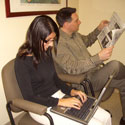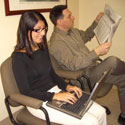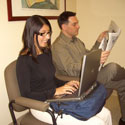Safety & Well-being
Login Tools
My Human Resources
Enter direct banking information, view earnings statements, change your address & manage training. [ LOGIN]
Pension Account
View pension plan balances and investment mix and choose your investments. [ LOGIN]
Manulife
Check and submit claims, get forms, print Manulife card. [ LOGIN]
Faculty Staff Resources
Salary ranges, pay schedules and related information. [ LOGIN]
Researcher Toolbox
Hiring/appointing research roles, including budgeting for salary and benefit costs. [ LOGIN]
Administrator Toolbox
Appointments and pay administration, offer templates. [ LOGIN]
Leader Toolbox
Help with recruiting, hiring, enhancing performance. [ LOGIN]
Western Financial
Submit expenses, PER inquiry, research grants. [ LOGIN]
Laptop Set-up

Laptop computers were originally designed as portable, compact computers for use on the road. It’s this compact design that adds to the potential for ergonomic risk with prolonged use. Unlike desktop computers, you cannot adjust the monitor and keyboard independently. Adjusting the keyboard to elbow height encourages neck bending when viewing the screen. While, raising the monitor to eye level and accommodating eye height will position the arms awkwardly.
Laptops were designed to work in small or even cramped spaces, often required to contend with poor lighting quality or screen glare. This may lead to poor working postures.
General Laptop Tips

Shoulders should be resting at your sides, elbows bent to 90 degrees and wrists straight. Tilt the screen to reduce neck bending and any glare.
Make sure you use a light touch while keying and mousing.

The armrests on your chair should not obstruct arm movements as seen in the picture to the right.
Can you use secondary function or short-cut keys instead of the mouse

Consider the tasks you will be working on. Raise the screen to eye level when reading lengthy documents (consider using the mouse for scrolling) or lower the keyboard to elbow level for intensive keying.
Consider using the laptop as a stand alone CPU with an external keyboard, mouse and monitor. If the notebook screen is large, raise the entire computer to eye level and use an external keyboard and mouse.

If you are working at a table that is too high for proper keying, try tilting the laptop towards you using an empty binder. Reclining your seat slightly will help to improve arm postures. Tilting the laptop will also help to raise the screen closer to eye level.
Take a break from your laptop. Do you have other jobs you can work at for a bit that don’t involve using a computer? Several short breaks, where you can change your posture, is recommended over one long break.
On the Go?

When on the go, your own lap can become a convenient place for your notebook. This location promotes ideal wrist postures, but places your neck in a bent forward position. If possible, switch the notebook between your lap and a table every 20 minutes.

When viewing the screen, tuck your chin in as opposed to bending your entire neck down.
Continue to use proper posture when using the laptop

Try placing a pillow under the notebook to raise the screen, improving neck posture.
Ask the hotel’s front desk if they have a work area set-up for laptop use or a docking station with peripherals for use in the room.

Does your laptop bag have wheels?

Can you limit the number of peripherals you need to carry with you? Do you need to bring the laptop or would a PDA suffice for the job (email, scheduling etc.)? Reducing weight will lessen strain on your body while on the go.
Published on and maintained in Cascade CMS.
